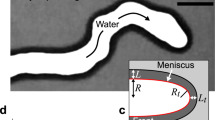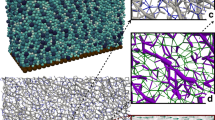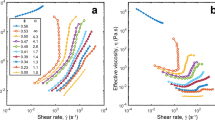Abstract
Amorphous glassy materials of diverse nature—concentrated emulsions, granular materials, pastes, molecular glasses—display complex flow properties, intermediate between solid and liquid, which are at the root of their use in many applications1,2,3. A general feature of such systems, well documented yet not really understood, is the strongly nonlinear nature of the flow rule relating stresses and strain rates4,5. Here we use a microfluidic velocimetry technique to characterize the flow of thin layers of concentrated emulsions, confined in gaps of different thicknesses by surfaces of different roughnesses. We find evidence for finite-size effects in the flow behaviour and the absence of an intrinsic local flow rule. In contrast to the classical nonlinearities of the rheological behaviour of amorphous materials, we show that a rather simple non-local flow rule can account for all the velocity profiles. This non-locality of the dynamics is quantified by a length, characteristic of cooperativity within the flow at these scales, that is unobservable in the liquid state (lower emulsion concentrations) and that increases with concentration in the jammed state. Beyond its practical importance for applications involving thin layers (for example, coatings), these non-locality and cooperativity effects have parallels in the behaviour of other glassy, jammed and granular systems, suggesting a possible fundamental universality.
This is a preview of subscription content, access via your institution
Access options
Subscribe to this journal
Receive 51 print issues and online access
$199.00 per year
only $3.90 per issue
Buy this article
- Purchase on Springer Link
- Instant access to full article PDF
Prices may be subject to local taxes which are calculated during checkout



Similar content being viewed by others
References
Jop, P., Forterre, Y. & Pouliquen, O. A constitutive law for dense granular flows. Nature 441, 727–730 (2006)
Debenedetti, P. G. & Stillinger, F. H. Supercooled liquids and the glass transition. Nature 410, 259–267 (2001)
Biroli, G. A new kind of phase transition? Nature Phys. 3, 222–223 (2007)
Coussot, P. Rheophysics of pastes: a review of microscopic modelling approaches. Soft Matter 3, 528–540 (2007)
Fuchs, M. & Cates, M. E. Theory of nonlinear rheology and yielding of dense colloidal suspensions. Phys. Rev. Lett. 89, 248304 (2002)
Goldenberg, C. & Goldhirsch, I. Friction enhances elasticity in granular solids. Nature 435, 188–191 (2005)
Ostojic, S., Somfai, E. & Nienhuis, B. Scale invariance and universality of force networks in static granular matter. Nature 439, 828–830 (2006)
Liu, A. J. & Nagel, S. R. Jamming is not just cool any more. Nature 396, 21–22 (1998)
Berthier, L. Time and length scales in supercooled liquids. Phys. Rev. E 69, 020201(R) (2004)
Weeks, E. R., Crocker, J. C., Levitt, A. C., Schofield, A. & Weitz, D. A. Three dimensional direct imaging of structural relaxation near the colloidal glass transition. Science 287, 627–631 (2000)
Berthier, L. et al. Direct experimental evidence of a growing length scale accompanying the glass transition. Science 310, 1797–1800 (2005)
Gao, Y. & Kilfoil, M. L. Direct imaging of dynamical heterogeneities near the colloid-gel transition. Phys. Rev. Lett. 99, 078301 (2007)
Priestley, R. D., Ellison, C. L., Broadbelt, L. J. & Torkelson, J. M. Structural relaxation of polymer glasses at surfaces, interfaces and in between. Science 309, 456–459 (2005)
Dauchot, O., Marty, G. & Biroli, G. Dynamical heterogeneity close to the jamming transition in a sheared granular material. Phys. Rev. Lett. 95, 265701 (2005)
Pouliquen, O. Velocity correlations in dense granular flows. Phys. Rev. Lett. 93, 248001 (2004)
Keys, A. S., Abate, A. R., Glotzer, S. C. & Durian, D. J. Measurement of growing dynamical length scales and prediction of the jamming transition in a granular material. Nature Phys. 3, 260–264 (2007)
Varnik, F., Bocquet, L., Barrat, J.-L. & Berthier, L. Shear localization in a model glass. Phys. Rev. Lett. 90, 095702 (2003)
Leonforte, F., Tanguy, A., Wittmer, J. P. & Barrat, J.-L. Inhomogeneous elastic response of silica glass. Phys. Rev. Lett. 97, 055501 (2006)
Isa, L., Besseling, R. & Poon, W. C. Shear zones and wall slip in the capillary flow of concentrated colloidal suspensions. Phys. Rev. Lett. 98, 198305 (2007)
Helbing, D., Farkas, I. & Vicsek, T. Simulating dynamical features of escape panic. Nature 407, 487–490 (2000)
Degré, G. et al. Rheology of complex fluids by particle image velocimetry in microchannels. Appl. Phys. Lett. 89, 024104 (2006)
Mueth, D. M. et al. Signatures of granular microstructure in dense shear flows. Nature 406, 385–389 (2000)
Princen, H. M. Rheology of foams and highly concentrated emulsions. J. Colloid Interface Sci. 91, 160–175 (1983)
Schall, P., Weitz, D. A. & Spaepen, F. Structural rearrangements that govern flow in colloidal glasses. Science 318, 1895 (2007)
Picard, G., Ajdari, A., Bocquet, L. & Lequeux, F. A simple model for heterogeneous flows of yield stress fluids. Phys. Rev. E 66, 051501 (2002)
Picard, G., Ajdari, A., Lequeux, F. & Bocquet, L. Slow flows of yield stress fluids: complex spatiotemporal behavior within a simple elastoplastic model. Phys. Rev. E 71, 010501(R) (2005)
Dhont, J. K. G. A constitutive relation describing the shear-banding transition. Phys. Rev. E 60, 4534–4544 (1999)
Kamrin, K. & Bazant, M. Z. A stochastic flow rule for granular materials. Phys. Rev. E 75, 041301 (2007)
Deboeuf, S., Lajeunesse, E., Dauchot, O. & Andreotti, B. Flow rule, self-channelization and levees in unconfined granular flows. Phys. Rev. Lett. 97, 158303 (2006)
Goldman, D. I. & Swinney, H. L. Signatures of glass formation in a fluidized bed of hard spheres. Phys. Rev. Lett. 96, 145702 (2006)
Acknowledgements
Discussions with J.-L. Barrat and B. Andreotti are acknowledged. This project was supported by Rhodia, Région Aquitaine and the ANR. L.B. acknowledges support from the von Humboldt Foundation.
Author information
Authors and Affiliations
Corresponding authors
Supplementary information
Supplementary information
The Methods describe : (PDF 2789 kb)
1. the properties of the emulsions used in this study 2. their bulk rheological properties 3. microchannels fabrication and characteristics 4. velocimetry techniques (IRM and -PIV) 5. local density measurements
The Supplementary Figures and Legends present :
1. a light-scattering characterization of the polydispersities of the two sets of emulsions used in this study 2. pictures of the smooth and rough surfaces of the microchannels 3. a velocity profile of an emulsion below the jamming point, demonstrating a very good agreement with a shear-thinning model without non-locality effects. 4. further measurements of the local flow curves for various confinements and surface roughness, hereby complementing the results presented in the main text. 5. further measurements of velocity profiles in the jammed state, here for the emulsion with 36% polydispersity, at a volume fraction of 75%. As in the main text - for the 20% polydispersity emulsion-, the non-local model is able to reproduce all experimental results using a single cooperativity length. 6. same as Supplementary Figure 5, but for the emulsion with volume fraction 80%. 7. Surface rheology for the emulsion. 8. Comparison of the experimental velocity profiles measured in 125 and 250 microns wide channels, with predictions using the local Herschel-Bukley flow curve. 9. Comparison of experimental velocity profiles with predictions obtained from alternative models involving non-locality (as proposed in Ref. [27]) 10. Spatial dependence of the volume fraction for various pressure gradients and confocal image of the emulsion under flow. 11. Local flow curves for various confinement ratio, /w.
The Supplementary Tables gather :
1. the parameters for the Hershel-Buckley model describing the bulk flow curve of the various emulsions used in this study. 2. the main characteristics of the microchannels (length, width, height and roughness type)
Rights and permissions
About this article
Cite this article
Goyon, J., Colin, A., Ovarlez, G. et al. Spatial cooperativity in soft glassy flows. Nature 454, 84–87 (2008). https://doi.org/10.1038/nature07026
Received:
Accepted:
Issue Date:
DOI: https://doi.org/10.1038/nature07026
This article is cited by
-
A FVM implementation and validation of non-local modeling for single- and two-phase granular flows
Computational Particle Mechanics (2022)
-
3D implementation and validation of VOF-coupled non-local granular rheology
Granular Matter (2022)
-
Carbon nanotube-reduced graphene oxide fiber with high torsional strength from rheological hierarchy control
Nature Communications (2021)
-
Billion degree of freedom granular dynamics simulation on commodity hardware via heterogeneous data-type representation
Multibody System Dynamics (2020)
-
Effect of geometrical confinement on the flow of soft microgel particle pastes
Rheologica Acta (2020)
Comments
By submitting a comment you agree to abide by our Terms and Community Guidelines. If you find something abusive or that does not comply with our terms or guidelines please flag it as inappropriate.



